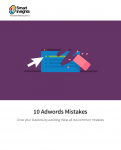A three-step approach to check for paid search campaign mistakes
In an ideal world, enterprising entrepreneurs would only need to set up shop, open their virtual doors, and find customers lining up to buy their products. Of course, it’s never that easy. Digital marketers have to actually go out looking for them. And once you find them, you need to convert them.

While conversion methods vary, many digital marketers arrive on a seemingly perfect solution when looking to invest to boost their visits: pay-per-click campaigns.
PPC campaigns can work, and some work quite well. But they can be minefields for mistakes, and the most common is the marketing equivalent of ‘keeping up with the Joneses.’ Many digital marketers think they should run a PPC campaign because everyone else is doing it.
Avoiding PPC mistakes
After initial setup of PPC by a startup or smaller business, there are a grab bag of issues which can be avoided to make your paid search investment more effective, including:
- Paying for it. Many companies run PPC campaigns without ever needing them. They already show up in the top rank of organic search results, so there isn’t a need. If you can get it for free, it isn’t worth a price — at least not a monetary one.
- Drawing a loyalty tax. If customers are searching for your brand directly, do you really need to bid on your company’s trademarks and related terms? Essentially, you’re being ‘taxed’ by Google for customers’ loyalty.
- Giving up control. For one reason or another, some companies leave ad management of PPC campaigns in the hands of Google. But Google isn’t concerned with conversions — at least, not directly — it’s primarily concerned with clicks.
- Firing and forgetting. Paid advertising is like day trading. Your returns often reflect the amount of time you devote to the campaign. You need to do more than just turn it on and turn it loose.
If you find that PPC is right for your business, it’s often best to approach it scientifically, which can help you determine what works. It also can help determine what isn’t working for an existing PPC campaign.
Determining what works for your PPC campaign
So many metrics and tools exist (not to mention a bevy of best-ways-to-do-this-or-that blog posts) that it’s becoming increasingly difficult to know what works. In my experience, it starts with diagnosing the problem with a PPC campaign, then resolving its underlying issues.
Together, this entails three steps:
- Step 1: Identify the objective. Most businesses have an objective for their PPC campaigns. It provides a point of reference to measure against, so pick the objective that matters most to you. Our company, for example, uses a metric to value visitor contributions to site performance. Your objective may be conversion rate.
- Step 2: Change the campaign. I’m not suggesting you change the entire campaign, but a piece or two that will likely positively affect your chosen objective. Maybe you swap some keywords in the campaign or revise the copy to make an impact.
- Step 3 Measure the impact. Did the metric change the way you expected? If you picked an objective that really matters and made a drastic change to the campaign, you’ll probably see speedy results. If you’re waiting months and there’s still no impact, rethink your change or even your objective.
Making a change with a negative impact isn’t the worst thing that could happen. The Internet has a ridiculously short memory, so simply revert back to your original approach, and the campaign will often start working like it did before. Then, go back to step one or step two and make a different change.
Strategizing PPC solutions
With any solution, it won’t do you much good if you just come to it haphazardly. You have to be strategic, and developing a strategy for diagnosing and remedying PPC issues often involves three factors:
- 1. Engagement: Define the value of customer engagement. How much are customers worth to you, not just in terms of revenue but total value? Do customers review or recommend your company’s products or services? Do they participate in non-revenue ways? Identify what these things mean to you.
Now, pick one visitor to start, and gather all of his or her information, such as purchase behavior, product selection, loyalty, visit lengths, click-through rates, and similar data. Given everything, how much is that customer worth?
- 2. Delivery: Define the value of your delivery. While delivery involves the value of your company’s products, it also relates to the value of other features, such as customer support, customer service, policies, procedures, and similar aspects of your business. Compare these features to those of other companies — both direct competitors and unrelated businesses. Are you delivering value? What’s this value worth to customers?
- 3. Interaction: Once you know the value of customers and your company’s worth to them (or at least what you think you’re worth), you have a foundation to strategically diagnose and remedy your PPC issues. You have something to measure and optimize.
If you know what consumers want, it’s much easier to give it to them. In turn, they’ll likely start giving you what you want.
So do your homework, and if you decide a PPC campaign is right for your company and check the agencies you’re working with are using an efficient PPC strategy.
Image credit/ Copyright: Anatolii Babii / 123RF Stock Photo.
